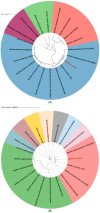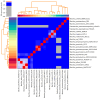Genomic Characterization of Bacillus sp. THPS1: A Hot Spring-Derived Species with Functional Features and Biotechnological Potential
- PMID: 39770679
- PMCID: PMC11727782
- DOI: 10.3390/microorganisms12122476
Genomic Characterization of Bacillus sp. THPS1: A Hot Spring-Derived Species with Functional Features and Biotechnological Potential
Abstract
Bacillus sp. THPS1 is a novel strain isolated from a high-temperature hot spring in Thailand, exhibiting distinctive genomic features that enable adaptation to an extreme environment. This study aimed to characterize the genomic and functional attributes of Bacillus sp. THPS1 to understand its adaptation strategies and evaluate its potential for biotechnological applications. The draft genome is 5.38 Mbp with a GC content of 35.67%, encoding 5606 genes, including those linked to stress response and sporulation, which are essential for survival in high-temperature conditions. Phylogenetic analysis and average nucleotide identity (ANI) values confirmed its classification as a distinct species within the Bacillus genus. Pangenome analysis involving 19 others closely related thermophilic Bacillus species identified 1888 singleton genes associated with heat resistance, sporulation, and specialized metabolism, suggesting adaptation to nutrient-deficient, high-temperature environments. Genomic analysis revealed 12 biosynthetic gene clusters (BGCs), including those for polyketides and non-ribosomal peptides, highlighting its potential for synthesizing secondary metabolites that may facilitate its adaptation. Additionally, the presence of three Siphoviridae phage regions and 96 mobile genetic elements (MGEs) suggests significant genomic plasticity, whereas the existence of five CRISPR arrays implies an advanced defense mechanism against phage infections, contributing to genomic stability. The distinctive genomic features and functional capacities of Bacillus sp. THPS1 make it a promising candidate for biotechnological applications, particularly in the production of heat-stable enzymes and the development of resilient bioformulations.
Keywords: Bacillus sp.; aquaculture; genomic adaptation; pangenome analysis; sporulation genes.
Conflict of interest statement
The authors declare no conflicts of interest.
Figures










Similar articles
-
Characterization, whole-genome sequence analysis, and protease production of a new thermophilic Bacillus licheniformis strain isolated from Debagh hot spring, Algeria.Int Microbiol. 2025 Apr;28(4):667-689. doi: 10.1007/s10123-024-00569-9. Epub 2024 Aug 12. Int Microbiol. 2025. PMID: 39129036
-
Genome Mining of Pseudarthrobacter sp. So.54, a Rhizospheric Bacteria from Colobanthus quitensis Antarctic Plant.Biomolecules. 2025 Apr 5;15(4):534. doi: 10.3390/biom15040534. Biomolecules. 2025. PMID: 40305262 Free PMC article.
-
Complete genome sequencing and comparative genomic analyses of Bacillus sp. S3, a novel hyper Sb(III)-oxidizing bacterium.BMC Microbiol. 2020 May 1;20(1):106. doi: 10.1186/s12866-020-01737-3. BMC Microbiol. 2020. PMID: 32354325 Free PMC article.
-
Antarctic Sphingomonas sp. So64.6b showed evolutive divergence within its genus, including new biosynthetic gene clusters.Front Microbiol. 2022 Nov 18;13:1007225. doi: 10.3389/fmicb.2022.1007225. eCollection 2022. Front Microbiol. 2022. PMID: 36466678 Free PMC article.
-
Staphylococcus edaphicus sp. nov., Isolated in Antarctica, Harbors the mecC Gene and Genomic Islands with a Suspected Role in Adaptation to Extreme Environments.Appl Environ Microbiol. 2018 Jan 2;84(2):e01746-17. doi: 10.1128/AEM.01746-17. Print 2018 Jan 15. Appl Environ Microbiol. 2018. PMID: 29079617 Free PMC article.
Cited by
-
Pathogenomic Insights into Piscirickettsia salmonis with a Focus on Virulence Factors, Single-Nucleotide Polymorphism Identification, and Resistance Dynamics.Animals (Basel). 2025 Apr 20;15(8):1176. doi: 10.3390/ani15081176. Animals (Basel). 2025. PMID: 40282010 Free PMC article.
-
Engineering Bacillus subtilis for high-value bioproduction: recent advances and applications.Microb Cell Fact. 2025 Aug 12;24(1):182. doi: 10.1186/s12934-025-02818-6. Microb Cell Fact. 2025. PMID: 40797206 Free PMC article. Review.
-
Benchmarking pangenome dynamics and horizontal gene transfer in Mycobacterium marinum evolution.Front Microbiol. 2025 Jun 17;16:1537826. doi: 10.3389/fmicb.2025.1537826. eCollection 2025. Front Microbiol. 2025. PMID: 40600140 Free PMC article.
-
Taxonomic Diversity and Antimicrobial Potential of Thermophilic Bacteria from Two Extreme Algerian Hot Springs.Microorganisms. 2025 Jun 19;13(6):1425. doi: 10.3390/microorganisms13061425. Microorganisms. 2025. PMID: 40572313 Free PMC article.
References
-
- Minnaard J., Rolny I.S., Pérez P.F. Laboratory Models for Foodborne Infections. CRC Press; Boca Raton, FL, USA: 2017. Bacillus; pp. 131–154.
-
- Kuan K.B., Othman R., Abdul Rahim K., Shamsuddin Z.H. Plant growth-promoting rhizobacteria inoculation to enhance vegetative growth, nitrogen fixation and nitrogen remobilisation of maize under greenhouse conditions. PLoS ONE. 2016;11:e0152478. doi: 10.1371/journal.pone.0152478. - DOI - PMC - PubMed
-
- Prashar P., Kapoor N., Sachdeva S. Rhizosphere: Its structure, bacterial diversity and significance. Rev. Environ. Sci. Bio/Technol. 2014;13:63–77. doi: 10.1007/s11157-013-9317-z. - DOI
-
- Federici B. Microbiology Monographs Inclusions in Prokaryotes. Springer; Berlin/Heidelberg, Germany: 2006. Insecticidal protein crystals of Bacillus thuringiensis.
LinkOut - more resources
Full Text Sources
Miscellaneous

